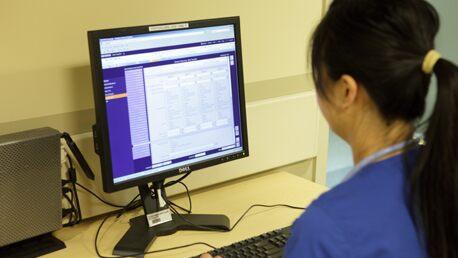February 12, 2014 | In the small town of Visalia in California, the Kaweah Delta Medical Center found a way to use IT to support efforts to improve its financial, clinical, and patient outcomes.
Text: Peter Jaret
Photos: Ye Rin Mok

Kaweah Delta Medical Center is in California's sprawling Central Valley, the most productive agricultural region in the United States. "I tell people that there are more cows in the county than people, which happens to be true," says Dave Gravender, the medical center's chief information officer. So it's appropriate that when Kaweah Delta created a new team dedicated to ensuring optimal healthcare delivery, they dubbed them "the wranglers" – a term used to describe ranch hands who herd cattle on horseback.

Like Seat Belt Warnings
The story began three years ago with a brainstorm. Kaweah Delta was using the Soarian® workflow engine to track its clinical processes. Gravender's idea was to use the engine not only to monitor clinical metrics but also to send out reminders or alerts to the medical staff when something that was supposed to happen didn't.
Gravender likens the idea to seat belt warnings in cars: "Most days I click on my seatbelt once I'm out of the driveway. But sometimes I get distracted and forget. After about 20 or 30 seconds, the seatbelt warning goes off to remind me. That's what we wanted to create for our medical team."

Defining Core Metrics for Value-Based Purchasing
In 2011, Kaweah Delta began working closely with Siemens consultants to map out reminders and silent alerts based on clinical quality measures identified by the Centers for Medicare & Medicaid Services (CMS) as part of its Value-Based Purchasing (VBP) program. They needed better visibility of VBP performance metrics. In addition, they wanted to leverage the Soarian workflow engine to support the organization’s initiatives for improving clinical quality and patient satisfaction.
The effort focused on four conditions: acute myocardial infarction, pneumonia, heart failure, and surgical care improvement. The first objective was to determine key indicators – specific prescription drugs or lab test results, for instance – that signal when a patient has one of these targeted conditions. The second objective was to send out reminders or alerts if a key step in the clinical process has been neglected or delayed. The project team developed workflows to meet both these objectives.

The Challenge: A Reliable Alert System
One of the biggest challenges was determining exactly when the reminders and alerts should fire – and who should get them. Mark Garfield, MD, Kaweah Delta's chief medical officer, explains: "What we wanted was a fail-safe system that would alert our staff if something fell through the cracks. If you send the alert too soon, there are a lot of unnecessary alerts and people start to ignore them. If you fire the alerts too late, there may not be enough time to get something done in the time frame required."
Deciding who should receive the alerts also posed a challenge. "No one works 24/7," says Gravender. "Some of our medical staff may only come into the hospital every other day. It doesn't help to send an alert about something that needs to be done within 24 hours to a physician or nurse who isn't coming in for a day or two."

A Dedicated Team
Instead, the medical center created “wranglers” – a dedicated team of nurse practitioners who would receive the reminders and alerts and make sure they reach the right person in a timely fashion. "The alerts prompt us to investigate the patient chart and identify missing items," says nurse practitioner Mary Staton, one of the wranglers. The nurse practitioners, who have prescribing authority, can respond directly. Or they may need to alert a physician or bedside nurse.
Earlier this year, the tools for acute myocardial infarction and surgical care improvement went live. Pneumonia and heart failure should be up and running soon. Already, the wranglers say, the system has triggered alerts for core measures that might otherwise have been overlooked or delayed. This has almost certainly improved patient care and outcomes.

Outstanding Results for Value-Based Purchasing
The new tool also promises to help improve Kaweah Delta's financial health. Starting in 2012, CMS began penalizing medical centers that fall short on a selected list of clinical quality measures and rewarding those that perform especially well. "For the current year under Value Based Purchasing, we have about $1.25 million that could potentially be withheld and another $1.25 million we could receive, for a total of $2.5 million," says Kaweah's CMO Garfield. "That's a significant part of our bottom line. We're convinced that the new alert system will help us meet the challenge of value-based purchasing."
Working with Siemens, Kaweah's team is also getting ready to launch a reporting system that will allow them to see how well the workflow reminders and alerts are working in real time. "The goal is immediate feedback," says Gravender. "How are we doing? What alerts are being ignored because they aren't relevant? Which ones are being acted on? How can we do better?"
The result will be better clinical processes, decision making, and documentation. With more accessible patient information, Kaweah Delta helps to improve its performance on core measures – increasing reimbursement dollars and saving millions each year. The bottom line matters, of course. "But in the end it's about the patient," says Gravender. "The goal is to develop tools that help us ensure that patients get the very best care we can give them."
Author’s Bio
Peter Jaret is a frequent contributor to the New York Times and other publications. He is the author of several books, including Nurse: A World of Care (Emory Press) and Impact: From the Frontlines of Global Health (National Geographic).

